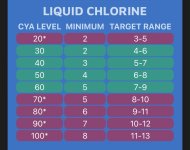Hello, When we got our spa we bought some sodium thiosulfate that came in handy whenever we accidentally added too much chlorine. The cover on the spa (275 gal.) is on except when in use in evenings and when adding chemicals and sits in the shade all the time. It definitely did the trick and of course learned early on not to add too much or all the chlorine was neutralized.
I spoke with the manufacturer this week about another issue and the rep randomly mentioned using MPS to 'shock' it periodically before adding more chlorine back in. I knew I didn't want to get too high CYA levels so I only used dichlor until the cya levels were good and then stayed with liquid chlorine throughout the week. So ...
Any reason to buy and use MPS instead of the thiosulfate we've been using (rarely now)?
Any reason to use a lot as a 'shock' weekly or biweekly and then start again?
With either option will shocking it remove CYA? She seemed to suggest using dichlor regularly but that continually raises cya is my understanding.
Thanks!
I spoke with the manufacturer this week about another issue and the rep randomly mentioned using MPS to 'shock' it periodically before adding more chlorine back in. I knew I didn't want to get too high CYA levels so I only used dichlor until the cya levels were good and then stayed with liquid chlorine throughout the week. So ...
Any reason to buy and use MPS instead of the thiosulfate we've been using (rarely now)?
Any reason to use a lot as a 'shock' weekly or biweekly and then start again?
With either option will shocking it remove CYA? She seemed to suggest using dichlor regularly but that continually raises cya is my understanding.
Thanks!


